How to Forecast and Measure Traffic Loss Due to the AI Overview Update
Junior SEO Specialist at Livepage

In recent months, SEO news feeds have been buzzing with discussions around Google's latest update: AI Overview. This is a section, featuring an extended AI-generated response, now increasingly appears above traditional snippets. On the one hand, users receive a polished, well-structured answer directly in the SERP. However, more and more brands are experiencing a sharp decline in traffic to their pages. Even ranking in the top 5 search results no longer guarantees a click. As a result, marketing teams are urgently seeking ways to estimate how much organic traffic the Google AI section may "consume," so their KPIs can reflect these new risks.
What Is AI Overview and How It Transforms the SERP
While we've long competed for top positions in search results, Google has introduced a new competitive layer: the AI Overview section, which now appears above classic search listings. When a user enters a query, the search engine no longer limits itself to a list of indexed links. Instead, AI Overview generates mini-report, consisting of several paragraphs with source citations.
Example of AI Overview in Google SERP
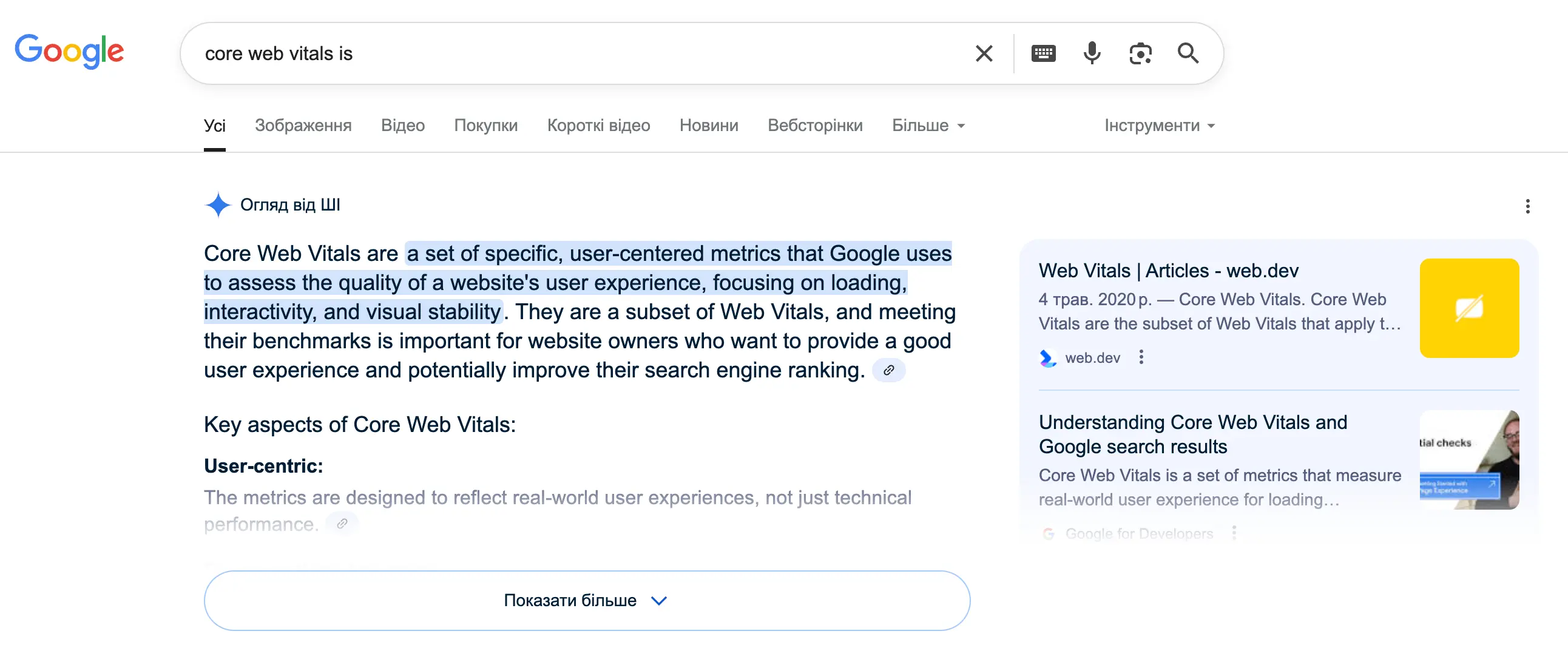
Let's take a closer look at how AI Overview works. The algorithm pulls data from authoritative pages — typically those already ranking in the top 10. It then synthesizes a coherent response and includes citations so readers can verify sources. This means users can get all the essentials without visiting the site. On desktop, the AI Overview occupies roughly one‑third of the visible screen, pushing other links down and effectively reducing the top 10 to a top 8. On mobile, it's even more pronounced: users often must scroll at least one screen to reach the first organic result.
Why Businesses Must Act Now
Back in 2023, this feature was only being tested in Search Labs. But starting in spring 2024, it gradually rolled out to all users in the US. As of May 2025, the AI Overview now appears in 13–15% of search queries, not just in America, but also in European countries.
According to the latest studies, users most often see this section for informational queries: nearly 9 out of 10 search phrases now trigger AI Overview. In less than six months, the share of such results has doubled, and it's not slowing down. Google now reports over 1.5 billion users who see an AI-generated answer at least once a month, in more than 140 countries.
Is this affecting businesses? Absolutely. For example, online stores are increasingly encountering situations where queries like "best ... for ..." are transformed by Google into ready-made product lists. As a result, users don't visit product category pages or comparison articles. Informational media are losing pageviews, and "How/What/Why" queries now often generate AI answers directly in the SERP. That means a drop in ad impressions (affecting PPC channels, too) and reduced page engagement. For SaaS projects, the risk lies elsewhere: AI Overview frequently explains how to complete a technical task without linking to the official product. As a result, the potential lead funnel narrows before the user even clicks.
Industries with the highest share of AI Overviews (May 2025)
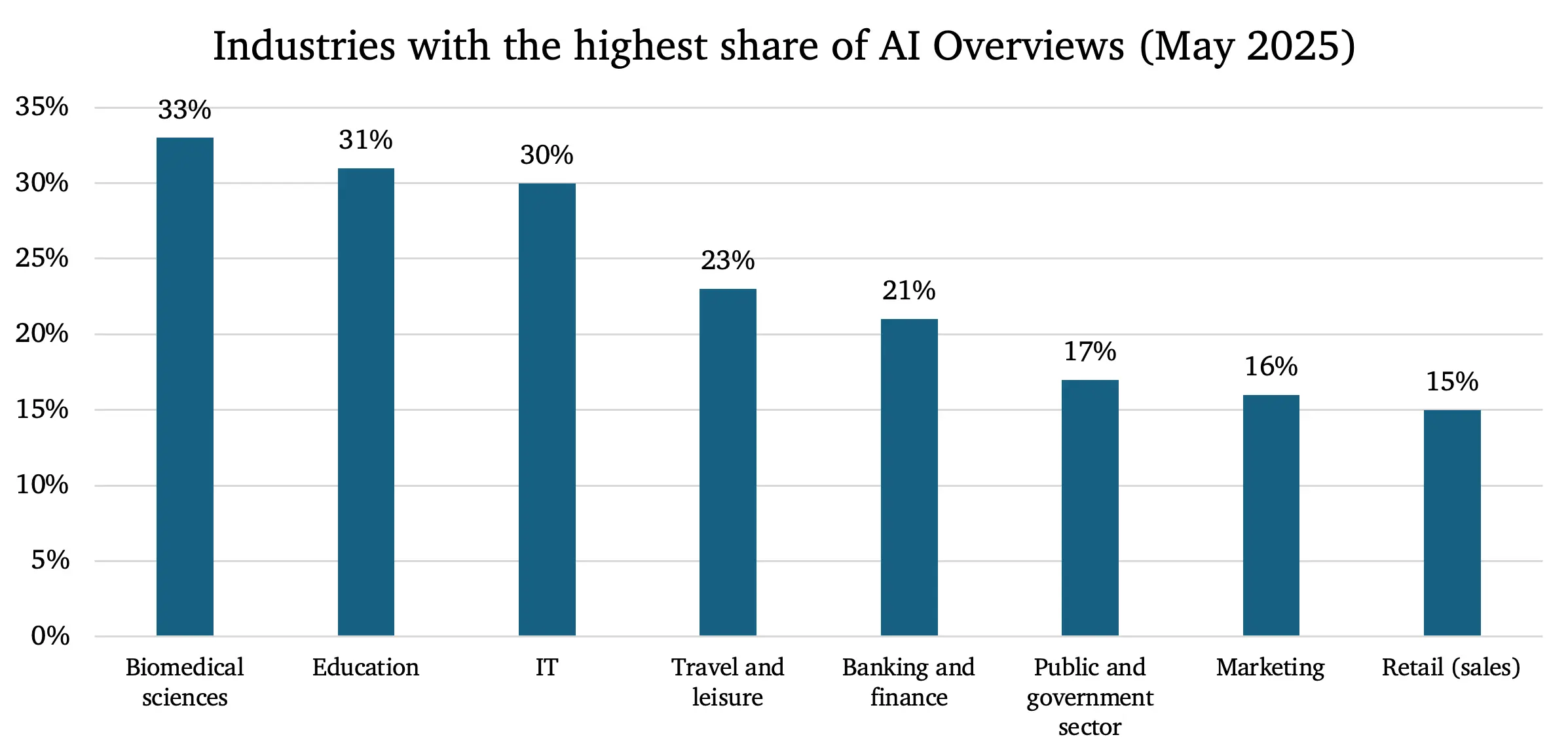
The risks of AI Overview are already being felt this quarter. Teams are forced to explore new ways to secure ad visibility in PPC slots (Google is currently testing ads inside its AI section). They also need to rapidly revise existing content to meet new requirements: short and clear answers, numbered lists, FAQs, structured microdata, etc.
When an AI Overview appears on the page, the user journey is reduced to just two steps: they read the ready-made answer and... that's it. One might argue that the AI block contains links to its sources, which is true. However, what incentive is there for a user to click if their question has already been answered? That's exactly why the share of so-called zero-click sessions, where the user doesn't visit any site, is growing rapidly.
CTR dynamics of an informational media site
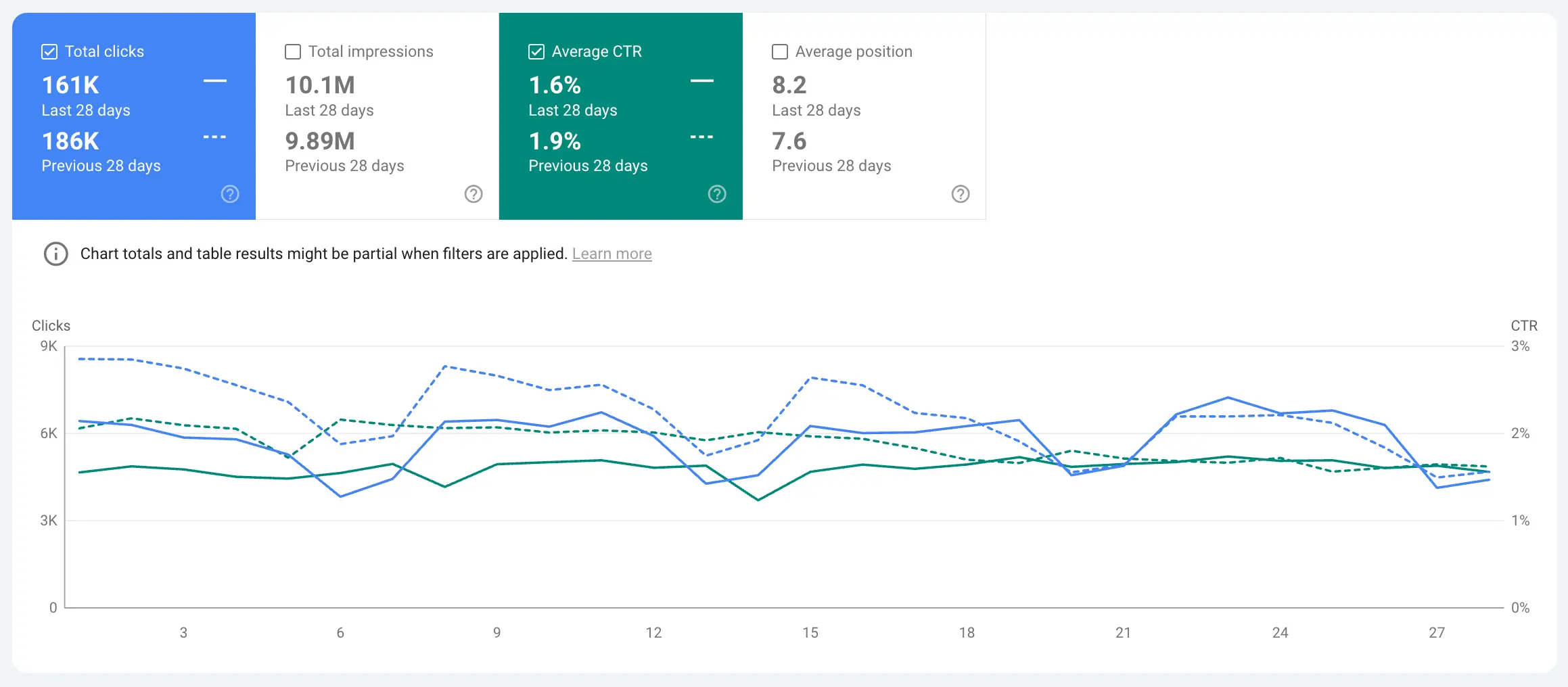
Research shows that since the launch of AI-generated responses, the total CTR of pages in Google's search results has dropped by nearly 30% over the past year, while the number of impressions has increased by 49%. The takeaway: demand still exists and continues to grow. But even if your site is included as a source in Google's AI answer, the chance that someone will actually click through is even lower than if it weren't mentioned at all.
If this factor isn't accounted for in your SEO reports, the picture may look misleadingly positive: position tracking tables will show growth, while actual traffic and sales may be declining.
So, the impact of AI Overview on business is clear:
• A decline in goals tied to organic traffic
• Increased cost-per-click in paid search as companies try to make up for losses through Google Ads
• A reassessment of SEO KPIs, as now, what matters is not just your ranking, but also whether you're featured in the AI response.
Estimating and Forecasting Potential Traffic Loss from AI
Now that we've clarified why AI-generated answers "consume" your search traffic, it's logical to move from theory to practical steps. All further actions will be done using Serpstat — a tool the Livepage team frequently relies on as a trusted SEO assistant with many useful features.
Start by checking which keywords are already covered by the AI Overview. To do this, go to the "Keyword Selection" tab and enable the green "AI Overview Keywords" toggle. In one click, you'll get a clean sample of queries where Google is already showing AI-generated responses.
Filtering keywords by AI presence in Serpstat
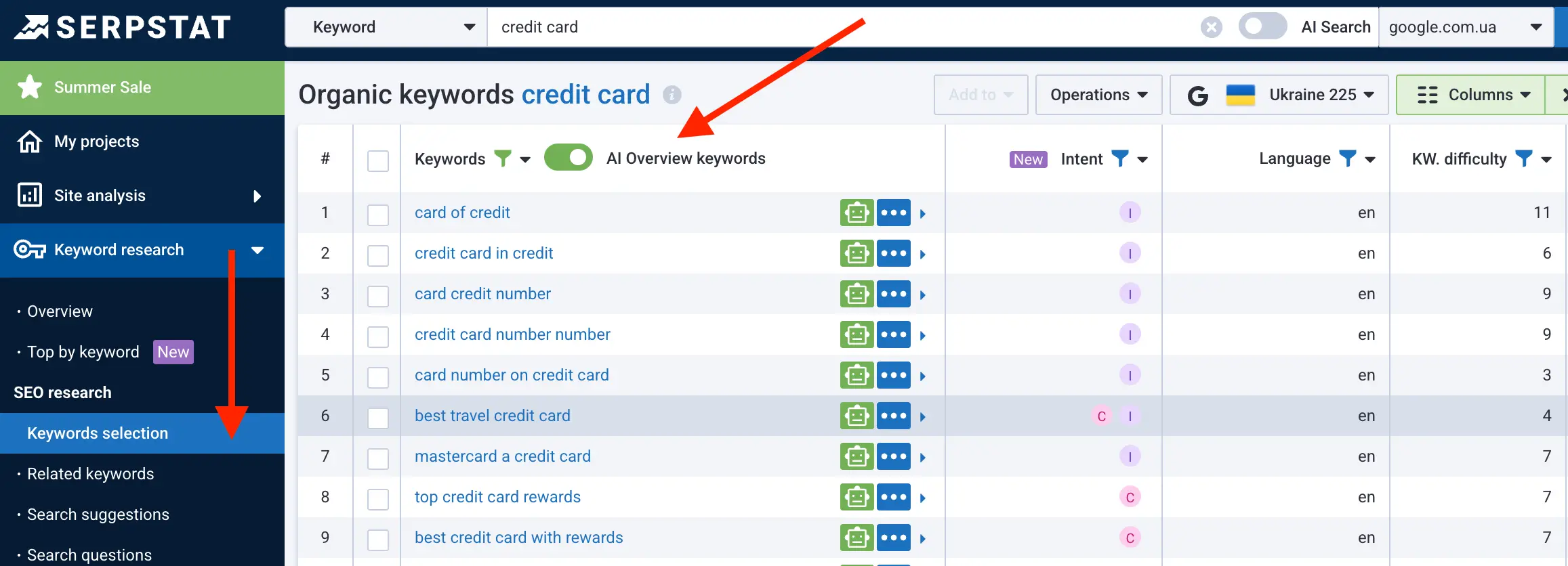
As you can see, even for a broad query like "bank card", dozens of long-tail variations that Google uses in its AI answers are instantly filtered. This is a new entry point for us when we see a set of keywords where we may already be losing clicks.
Special tag for keywords in AIO
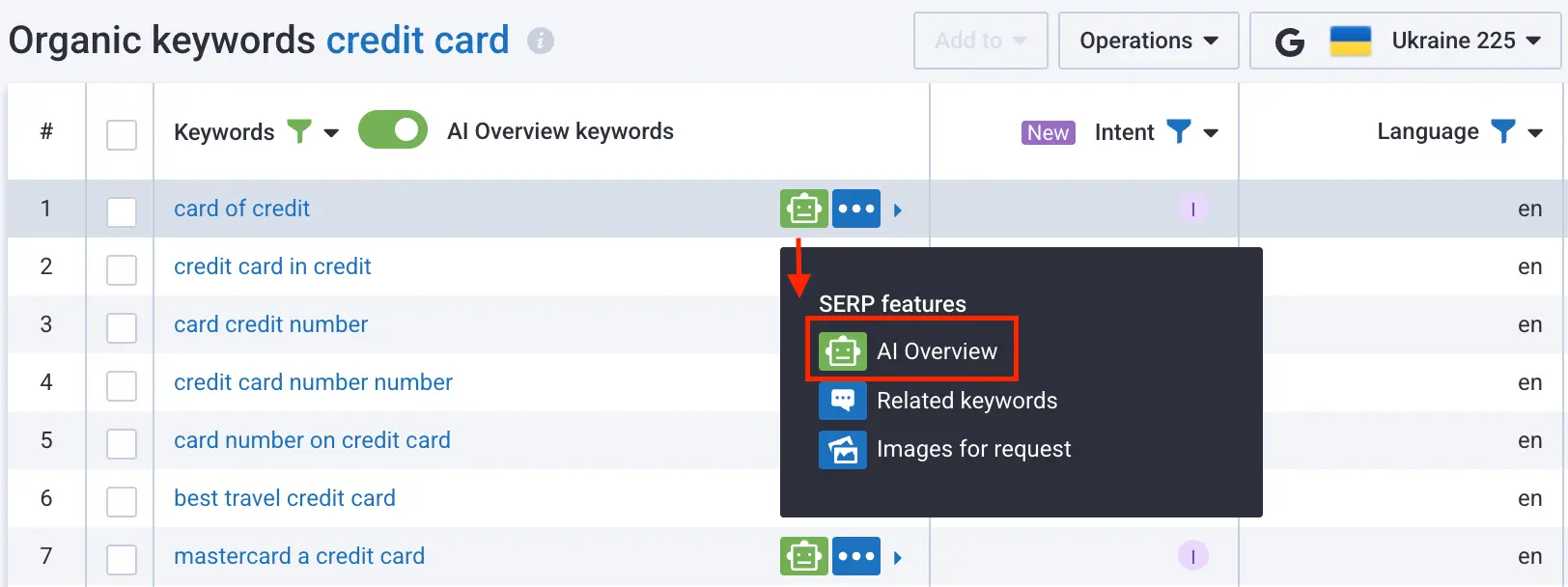
To get a clearer picture, export the list in a convenient format (CSV recommended). Then run clustering on these queries using the "Clustering" tool. In the settings window, select the clustering type and connection strength. This is how Serpstat groups the keywords using different criteria.
Clustering interface in Serpstat
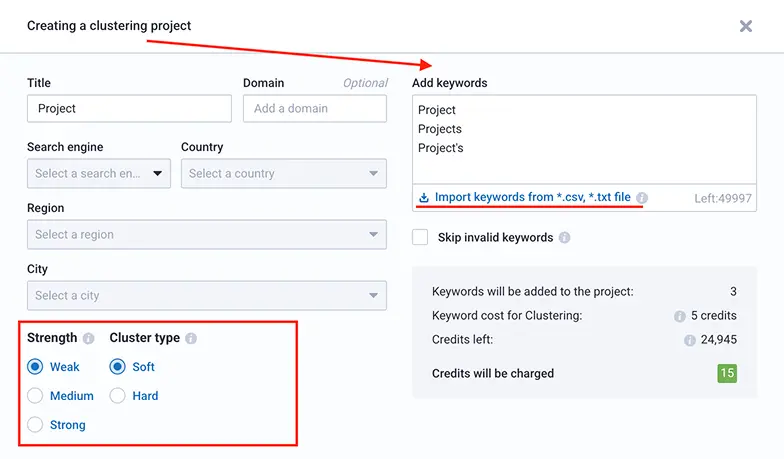
In a few minutes, you will have a list of thematic clusters for each of your pages. Each cluster contains key metrics (frequency, competition) and, most importantly, the "AI Overview" tag. These keywords can then be used to optimize your content not only for users but also for Google's AI output.
Next, go to the "Site Analysis" tab in the "Keywords" section and select your domain or the desired URL. Already at this stage, you can see what portion of your keywords may be "consumed" by AI responses. Simply choose the "SEO" keyword type and activate the AI Overview toggle.
Filtering AI Overview keywords for your domain
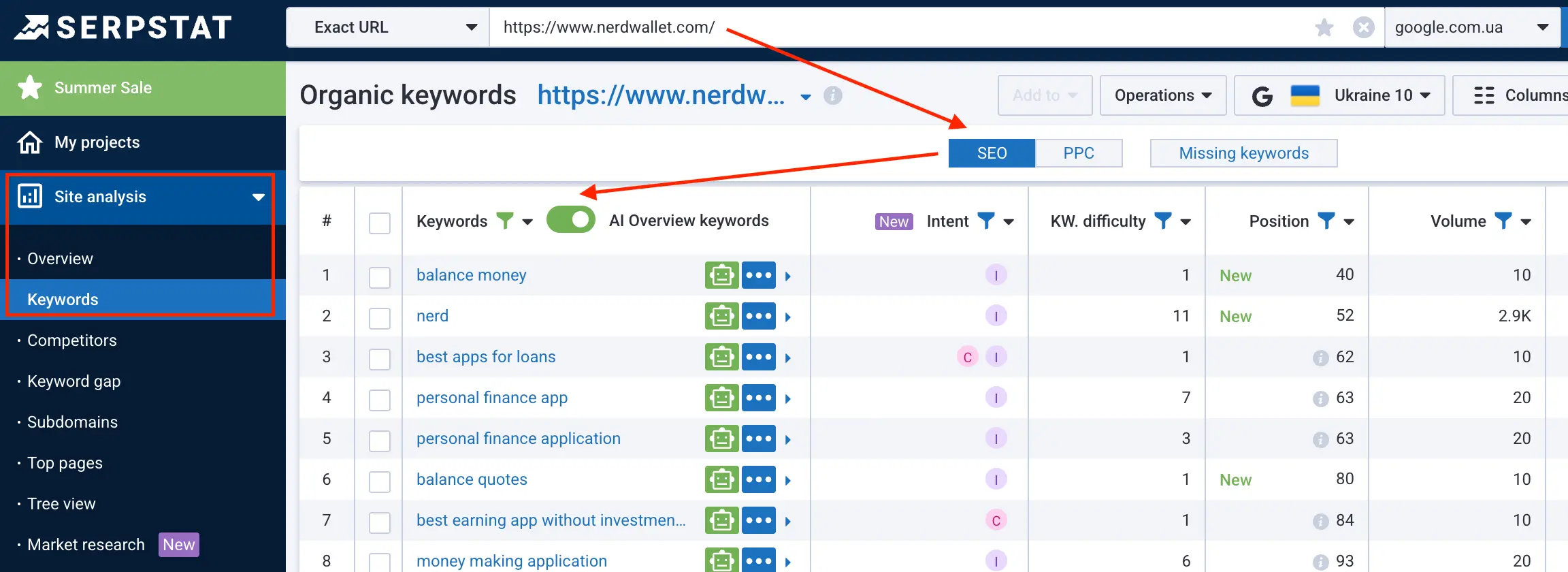
You will instantly see which queries your site ranks for and where it's simultaneously competing with AI-generated answers. You can also apply a filter for keywords already included in your AI cluster. This makes it easy to understand which topics have already been impacted by Google's AI and which are still in the risk zone. The same filter can later be used to form a strategy for minimizing these risks.
Filtering AI phrases for your site by keyword cluster

Now that the queries and URLs are neatly organized, let's move on to the math. For each page, take its CTR from Google Search Console or Serpstat's module, and subtract roughly one-third. This is the average drop the top 5 results experience when AI content appears above them, according to external research. Multiply the adjusted CTR by the new monthly impression volume to get a forecast of "after" clicks. By comparing this with the previous click data, you'll get the projected traffic loss.
For example, a page that was in second place in the search results and received 2,700 clicks from 10,000 impressions will drop to around 1,900 clicks after the adjustment, even if the number of impressions increases.
Once you have analyzed Google's AI results, gathered and grouped risky AI phrases, the next question is: where should you display these numbers so that a marketer or business owner can understand the trend at a glance? Serpstat has tools for this as well.
For example, to avoid missing the moment AI responses begin appearing in clusters of your keywords, add the selected phrases to "Rank Tracking." After applying the "AI Overview" filter, simply highlight the relevant keyword rows and click "Add phrases to Rank Tracking." Serpstat will start checking daily whether the AI Overview is still present in the search results, and where your page ranks relative to it.
Adding AI phrases to Serpstat rank tracking
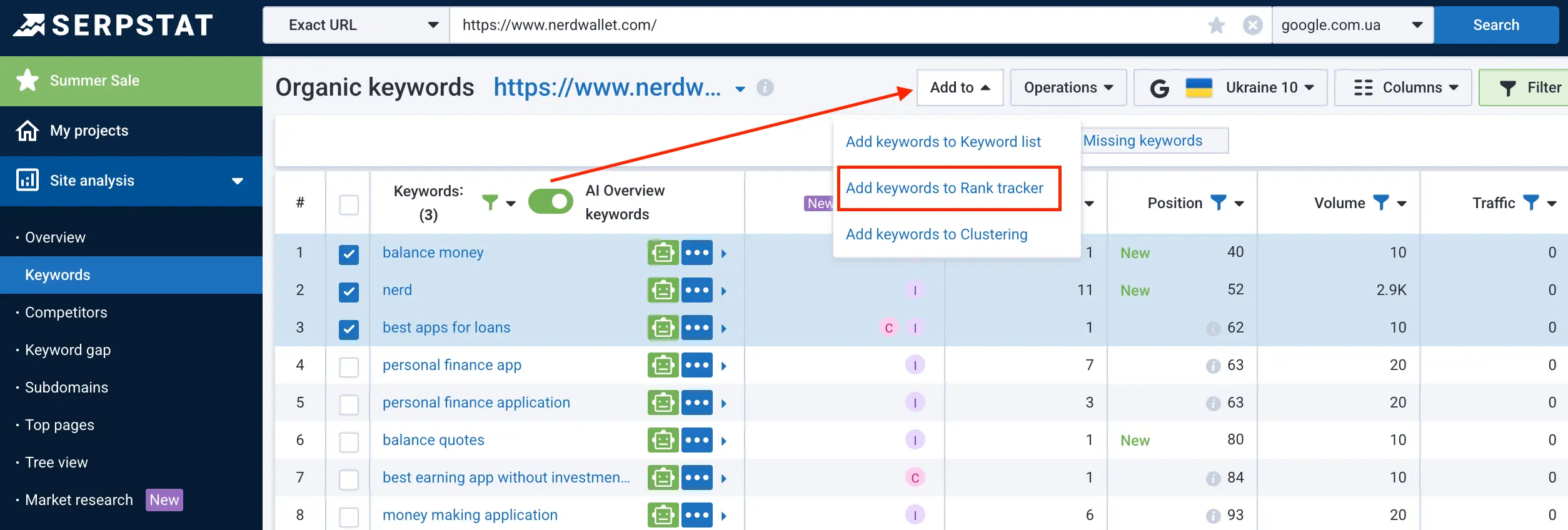
Another handy feature is the ability to bring the collected data into unique analytics. In the left-side menu of Serpstat, under "Integrations and Tools", you can choose plugins and integrations with popular applications. For Livepage, one of the priorities is synchronizing Serpstat with Looker Studio. Just authorize via API token, and all the necessary reporting fields (Keyword, AI Overview, Search Volume, etc.) will become available in your BI dashboard.
Visualizing collected analytics via Serpstat integrations and API
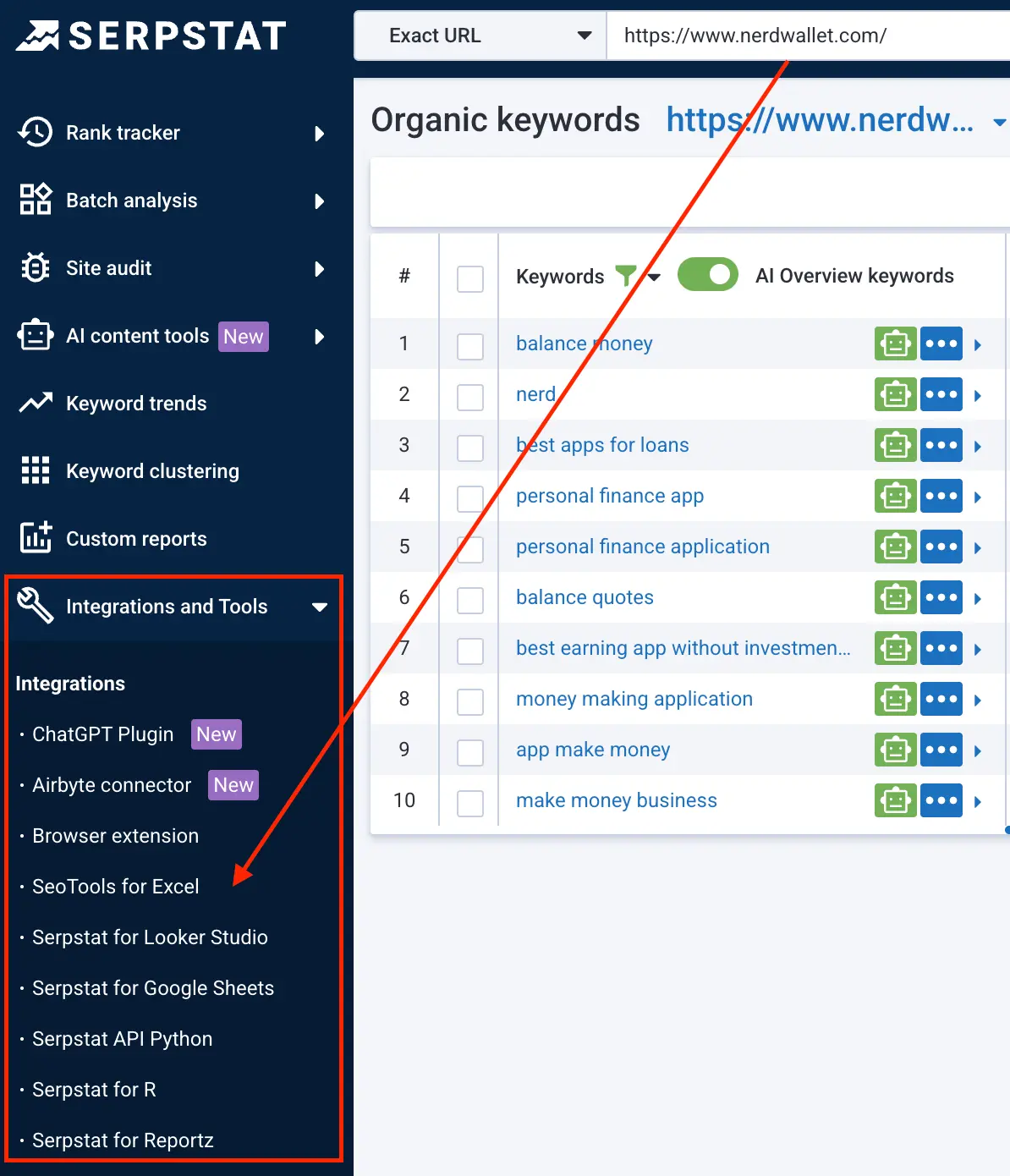
Does everyone really need this kind of visualization? How will the graphs differ? How useful is AI Overview data for users? In fact, this kind of modeling is important for all types of businesses, although its impact will vary depending on the specific industry.
Example of Serpstat data visualization in Looker Studio
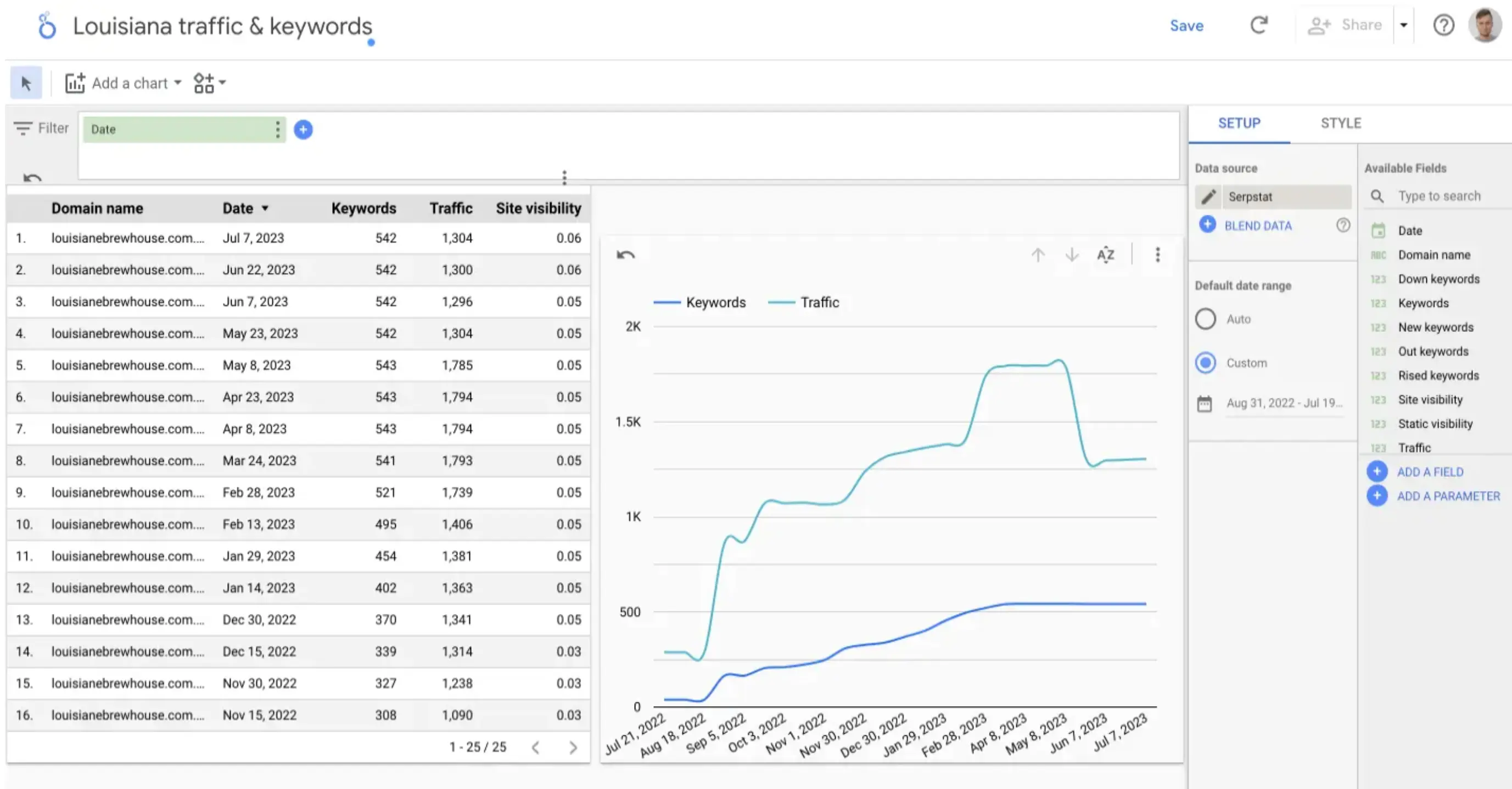
For large online stores, it's important to track trends and seasonality weekly. So, as soon as AI responses for product-related queries like "Best ..." exceed 10–15%, it's time to prepare for traffic loss and adapt pages to the new AI-driven reality.
Informational and media websites will mostly focus on the absolute share. If today, Google AI Overview already covers a third of their informational queries, each new percentage point means a direct loss of traffic that must be compensated through other acquisition channels.
For local B2B industries or narrow SaaS projects where the share of AI Overview is still only 3–5%, such a graph becomes a kind of "early warning system," helping you avoid missing the moment when the AI search enters your industry.
Strategies for Minimizing Losses and Adapting Content with Serpstat
The first thing to do after completing the AI audit mentioned above is to optimize your website content. Give it a chance to be cited inside the AI section or at least maintain its own clickability.
To make sure your optimization for AI Overview delivers the expected results, use Serpstat's AI Content tool. For example, the "Text Editor" tab lets you generate a draft article in just a few clicks, add a relevant FAQ, or create a summary. These are the kinds of fragments that Google most often includes in its AI responses.
If the piece is already published, the tool also lets you quickly refine key paragraphs, making them more concise without changing their meaning. This feature is especially useful when you need to fit the main facts into the first 200 characters to increase your chances of being cited in the AI Overview.
"Text Editor" tool, Serpstat
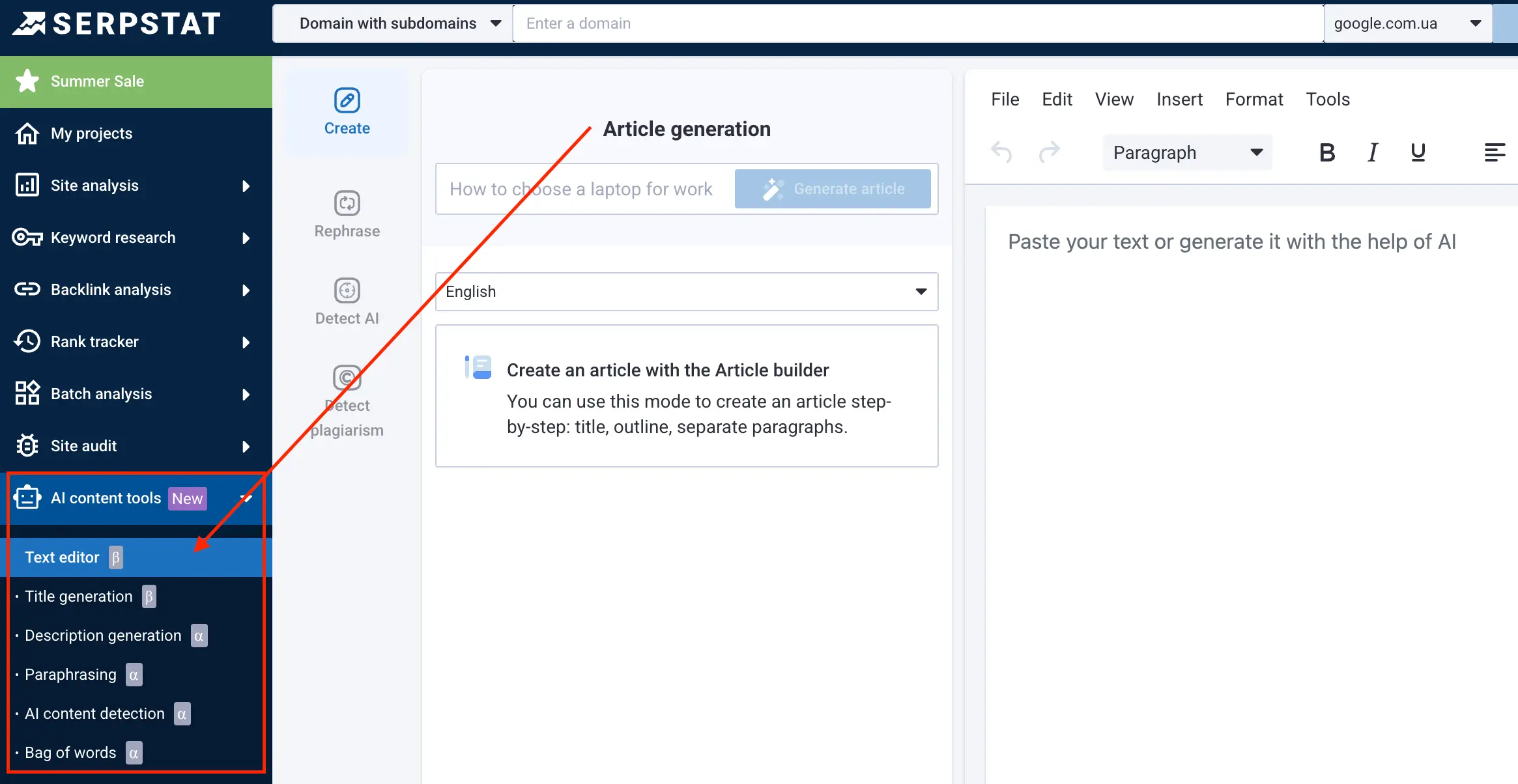
When aiming to appear in the AI Overview, make use of the previously researched and clustered AI keywords. This will help prevent users from disappearing in zero-click sessions. To do this, use the "Keyword Gap" report in the "Site Analysis" → "Keywords" section for a specific URL or the entire domain. This report shows which search queries are not yet mentioned on your page but are already bringing traffic to competitors.
Identifying missing keyword queries for your domain

By further filtering out queries missing from the previously collected cluster, you can add such keywords to subheadings or the FAQ section, since they haven't yet become keywords for AI Overvie w. This not only helps you regain lost rankings but also provides new anchors for internal linking.
Filtering missing keyword queries by cluster inclusion

At the same time, it's worth diversifying your current marketing channels. While Google experiments with ads inside AI Overviews, brands are trying to win back audiences through short-form video in Reels and Shorts, TikTok ads, or other platforms not yet influenced by AI. Please note that email marketing still works well in many industries. One thing is clear: the more niche your topic, the more precise and expert your content needs to be.
Alternative Traffic Acquisition Methods by Livepage
The Livepage team has been working with search traffic and businesses from various industries since 2012. Over this time, we have grown from a small studio into an international agency, recognized in global rankings such as Clutch and GoodFirms.
When Google began its large-scale rollout of AI Overview, we focused not only on classic on-site optimization but also on semantic link building, a strategy that combines working with semantics (keywords) and outreach on authoritative platforms.
We begin by thoroughly researching the industry: selecting expert topics and high-frequency keywords that are still not covered by the AI Overview but are actively attracting audiences. Then we create relevant content based on the researched keywords. After that, the content is published on external, topic-specific websites.
Semantic link building is especially useful in niches where AI Overview aggressively reduces organic traffic: educational platforms, IT services, and eCommerce with product selections. Additionally, this strategy improves a site's visibility in other AI-powered tools like ChatGPT, Perplexity, Grok, Copilot, and more.
A clear proof of this approach is our case study " Link Building for Search GPT." For a client in the B2B, we developed a strategy aimed not only at promotion in Google but also at visibility in neural search engines like ChatGPT and Perplexity. In the first three months, the team audited competitors in AI search results, built a "knowledge base" for the brand, created AI-friendly content, and placed relevant mentions of the client on platforms already appearing in AI-generated responses. As a result, AI search traffic doubled, and the new traffic brought in targeted leads for the client.
Key Takeaways
As we can see, AI Overview has already changed the rules of the game for organic traffic — ranking in the top results no longer guarantees growth in visits, and each additional percentage of AI-generated answers in the SERP can negatively affect your revenue.
If your analytics show a drop in clicks and CTR, but your rankings and impressions remain stable, it's a clear signal to check whether you are losing traffic due to AI Overview. Livepage is ready to conduct a quick diagnostic: we will show you how to regain visibility and develop a clear SEO strategy that meets current demands in the context of AI Overview's expansion.
By combining our expertise with Serpstat's tools, you can not only patch the gaps but also turn Google's algorithm changes to your advantage.
The opinion of the guest post authors may not coincide with the opinion of the Serpstat editorial staff and specialists.
Check AI Overview Impact
Enter a keyword or domain to analyze
Discover More SEO Tools
Website Audit
Website SEO analysis – gain detailed insights into your website's technical health
Batch Analysis of Competitors' Domains
DA Domain Checker – get valuable information about the competitors' domains
AI Content Tools
AI Content Marketing Tools – simplify and optimize the content creation process
Local SEO Tool
Our local SEO platform – optimize your website for maximum impact
Recommended posts
Cases, life hacks, researches, and useful articles
Don’t you have time to follow the news? No worries! Our editor will choose articles that will definitely help you with your work. Join our cozy community :)
By clicking the button, you agree to our privacy policy.